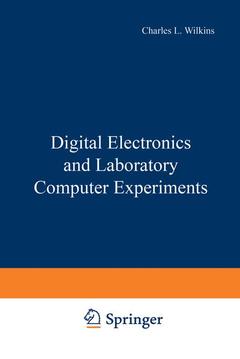Description
Digital Electronics and Laboratory Computer Experiments, Softcover reprint of the original 1st ed. 1975
Author: Wilkins Charles
Language: English
Subject for Digital Electronics and Laboratory Computer Experiments:
Keywords
computer system; development; electronics; experiment; instruments; system
Approximative price 52.74 €
In Print (Delivery period: 15 days).
Add to cart
Publication date: 12-2012
284 p. · 17x24.4 cm · Paperback
284 p. · 17x24.4 cm · Paperback
Description
/li>Contents
/li>
Science undergraduates have come to accept the use of computers as commonplace. The daily use of portable sophisticated electronic calculators (some of them rivaling general-purpose minicomputers in their capa bi li ti es) has hastened this development. Over the past several years, computer assisted experimentation has assumed an important role in the experimental laboratory. Mini- and microcomputer systems have become an important part of the physical scientist's array of analytical instruments. Prompted by our beliefthat this was an inevitable development, we began several years aga to develop the curricular materials presented in this manual. At the outset, several objectives seemed important to uso First, insofar as possible, the experiments included should be thoroughly tested and error free. Second, they should be compatible with a variety of laboratory computer, data-acquisition, and control systems. Third, little or no previous background in either electronics or programming should be necessary. (Of course, such background would be advantageous. ) To satisfy these objectives, we decided to adopt a widespread high-level computer language, BASIC, suitably modified for the purpose. Furthermore, we have purposely avoided specifying any particular system or equipment. Rather, the functional characteristics of both hardware and software required are stipulated. The experiments have been developed using Varian 620 and Hewlett-Packard 2100 series computers, but we believe they are readily transferable to other commonly available computer systems with a minimum of difficulty.
Section I. Principles of Digital Logic.- to Experiments 1–5.- Experiment 1. DC Properties of Logic Elements.- Experiment 2. Complex Logic Functions from Simple Gates—Part 1.- Experiment 3. Complex Logic Functions from Simple Gates—Part 2.- Experiment 4. Other Useful Solid-State Devices.- Experiment 5. Properties and Use of Digital-to-Analog (DAC) and Analog-to-Digital (ADC) Converters.- Section II. Principles of Interfacing.- to Experiments 6–17.- Experiment 6. Computer-Controlled Logic Chip Test.- Experiment 7. Computer-Controlled Analog-to-Digital Conversion.- Experiment 8. Graphic-Display Experiments Using an X-Y Plotter and/or Storage Oscilloscope.- Experiment 9. Transient Decay Signal (Capacitor Discharge).- Experiment 10. Ensemble Averaging of Repeatable Noisy Signals.- Experiment 11. Multiplexing Using Triggerable Distinct Waveforms.- Experiment 12. Determination of Data-Acquisition Rate—The Nyquist Frequency.- Experiment 13. Computer-Aided Demonstration of the Photoelectric Effect.- Experiment 14. Computer-Assisted Potentiometric Titrations.- Experiment 15. On-Line Digital Computer Applications in Gas Chromatography.- Experiment 16. On-Line Digital Computer Applications for Kinetic Analysis.- Experiment 17. Computer-Controlled Colorimetry.- Section III. Appendices.- Appendix A. REAL-TIME BASIC (RTB) for Varian 620 Computers (Oregon/Nebraska Version).- Appendix B. Purdue real-time basic.- Appendix C. General-Purpose Interface and Logic Experiment Devices.- Appendix D. Equipment and Reagents List.- Appendix E. Schematics of Special Devices Used in This Book.- Appendix F. Detailed Description of Data-Acquisition Interface for Hewlett-Packard 2100-Family Computer Systems.- Appendix G. Interpreting Specifications Found on Digital Integrated-Circuit Data Sheets.- Appendix H. Operational Amplifiers.- Appendix I. Bibliography.
© 2024 LAVOISIER S.A.S.

